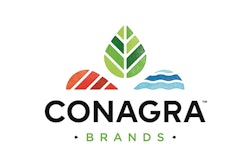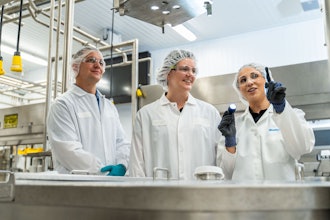
(The Conversation is an independent and nonprofit source of news, analysis and commentary from academic experts.)
When I was conducting fieldwork on the chocolate industry in Ghana in 2005, I satisfied my cravings with Golden Tree chocolate bars. The brand was local, made with a fraction of Ghana’s enormous cocoa output by the Cocoa Processing Company in the coastal town of Tema.
Air-conditioned shops at petrol stations usually carried the brightly wrapped bars, especially in cities. But mostly it was women at roadside stalls or children who wove through traffic, transacting through car windows, who sold the chocolates.
As a chocolate lover, I enjoyed eating Golden Tree. As a researcher, I was intrigued by a particular quality: the chocolate never melted. Despite an average daily temperature of nearly 80 Fahrenheit, Golden Tree chocolates retained their precise edges and pointed corners. This was a mystery, as the labels listed cocoa butter as the only fat.
So how did they do it? The global chocolate industry, whose value is expected to climb to nearly $100 billion by 2016, would dearly love to know.
Melts in Your Mouth
Chocolate is compelling to the human palate partly because cocoa butter, the natural fat of the bean, melts at just below our body temperature, around 93 degrees Fahrenheit. If you hold chocolate in your hand, it ought to melt. Obviously most of us would rather the chocolate melted in our mouths – hence the famous Mars M&M slogan and candy shells, designed to prevent premature melting. But this melting property of cocoa butter gives chocolate its distinctive mouth-feel, covering our taste buds thickly and evenly. We feel as well as taste.
The manufacturing step that keeps cocoa butter stable until it does reach our mouths is tempering. Cocoa butter fat crystallizes in six forms, and only the fifth of these produces the ideal shine and pleasing “crack” of fresh chocolate. Stored properly at room temperature, this form will maintain for a long time: dark chocolate generally has a two-year best-by date, and milk chocolate, one (due to the dairy). In my experience, these are conservative estimates.
However, if the chocolate heats up and then cools, the fat crystals break apart. The chocolate “blooms”: cocoa butter rises to the surface, creating a yellowish sheen or even a thick-ish layer of fat. It’s still edible, but obviously not very nice to look at, and bloom throws the texture off.
Blooming chocolate
In air-conditioned stores across North America and Europe, chocolate bars sit at checkout counters and retain their temper. But in hotter climes, selling chocolate is a persistent challenge.
For the global candy companies, which rely upon impulse buys that happen near the cash register, product visibility is key. This kind of placement is impossible when a shop is not air-conditioned. My experience in rural Sub-Saharan Africa, for example, is that chocolate either sits melting on a shelf or is at best buried in a chest freezer. There it remains unseen unless a shopper opens the freezer door.
Even in Africa’s mega-cities, which have better distribution infrastructure, finding in-temper chocolate is a challenge. In Lagos, Nigeria, where I live part-time, I buy imported chocolate from stores with modest air-conditioning and regular shipments. I always find a thin sheen of cocoa butter bloom on these bars. Somewhere between factory and store shelf, the cold chain failed.
In short, keeping chocolate shiny and shaped like a bar is not easy. It requires a comprehensive cold chain, from refrigerated trucks to display cases that both maintain temper and offer high visibility. In rural areas, this cold chain must extend to villages where electricity is often lacking.
During my doctoral research, I interviewed rural shopkeepers in Ghana’s Ashanti and Western regions. For the most part, they chose not to stock chocolate, even though we were in the heart of cocoa-growing country. Chocolate that melted at higher temperatures might be a more attractive inventory for these shopkeepers.
This, in turn, could make chocolate more readily available to farmers themselves. Though they spend their lives growing cocoa, most farmers cannot afford to buy expensive chocolate bars for sale in towns and cities. A cheap, heat-resistant chocolate that stayed fresh in rural shops might make it possible for cocoa farmers to enjoy chocolate, too.
Chocolate on the Battlefield
Early innovations in heat-resistant chocolate did not focus on farmers, but on the armed forces. In 1937, Hershey began developing a heat-resistant bar for the U.S. Army, which resulted in the Field Ration D.
According to the Hershey Community Archives, “It has been estimated that between 1940 and 1945, over three billion ration units were produced and distributed to soldiers around the world.” The corporation eventually received the Army-Navy E Award – given to companies that have “achieved outstanding performance on war production” – for creating the heat-resistant bar.
As Joël Glenn Brenner documents in Emperors of Chocolate: Inside the Secret World of Hershey and Mars, the longstanding battle between these two chocolate giants for US market dominance has also played out as a rivalry for military supply contracts. This prompted further research into heat resistance as conflict moved to the sweltering Middle East over the 20th century.
Indeed, Glenn Brenner opens her book with the crisis that looms in Mars’ Middle East operations on the eve of the first Gulf War in 1990. As Saddam Hussein invaded Kuwait, the ensuing panic threatened Mars’ regional distribution network. At the time, Glenn Brenner notes, the region brought in sales revenue of $40 million. Those Snickers bars were not heat-resistant and, with distribution compromised, sales seemed doomed.
Ironically, the same conflict that threatened the fragile inventory ultimately supplied an alternative market: Mars sold the candy to arriving British and American armed forces. At the same time, the company enjoyed its real coup over Hershey. Mars was already supplying the armed forces with heat-resistant M&Ms. Though Hershey’s Desert Bar received media attention during the Gulf War, the soldiers were eating Mars candy.
Today, the target consumers for heat-resistant chocolate are civilians in emerging markets. These markets hold enormous potential.
In Chocolate Fortunes: The Battle for the Hearts, Minds, and Wallets of China’s Consumers, Lawrence L Allen documents the fierce competition among Cadbury, Hershey, Mars, Nestlé and Ferrero for the one billion potential customers in China. By 2008, he noted, “annual retail chocolate sales in China [were] approaching $1 billion."
Seven years later, emerging chocolate markets include not just China but the Indian subcontinent, Sub-Saharan Africa, the Middle East and Indo-Pacific. Euromonitor predicts that the combined markets for chocolate across Asia-Pacific, Latin America, the Middle East and Africa will surge more than 50 percent to $48 billion by 2019, Bloomberg Business recently reported. The fastest growth rates are predicted for the Middle East and Africa. These are places where cold chains are least developed. Hence, the solution to chocolate distribution lies in its melt.
Cracking the Secret to Heat Resistance
As the taste for chocolate moves beyond the temperate zones and emerging chocolate markets swell, the quest for higher chocolate melting points has become more intense.
As Bloomberg reported, Barry Callebaut, one of the world’s largest chocolate-makers, can make a bar that remains stable at up to 100 degrees Fahrenheit. Nestlé, Hershey and Mondelez International also have heat-resistant projects in the works. Meanwhile, researchers at Penn State’s College of Agricultural Sciences announced in April their discovery of the gene that determines cocoa butter’s melting point. If this gene can be manipulated, it may mean another route to heat-resistant chocolate.
Back in Ghana, I eventually gained entry to the Cocoa Processing Company factory in Tema. I had a tour of areas that made semi-finished products, including cocoa butter. But when we reached the section that made Golden Tree chocolate, I was told that no visitors were allowed. Instead, my guide led me back to reception, where I viewed a film on how they made their chocolate confections. I never did discover how Golden Tree became non-meltable.
But the achievement is likely to be replicated on a much larger scale, and soon. As researchers and scientists race toward this engineering feat, the result will one day be a planet covered in chocolate – sharp and square, in its most pleasing form, and ready to melt where it ought: in our mouths.
This article is republished from The Conversation under a Creative Commons license. Read the original article here.



















